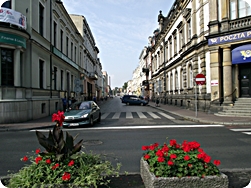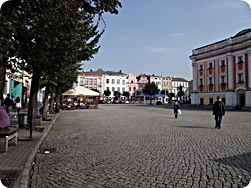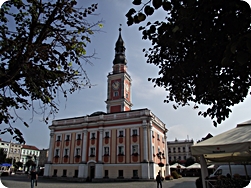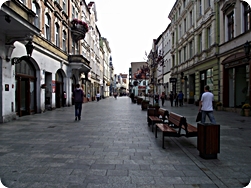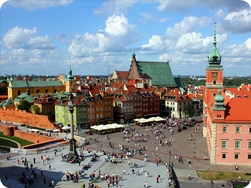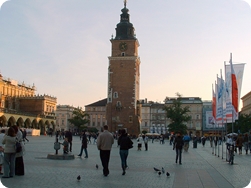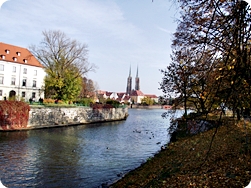
Leszno Travel Guide
Leszno
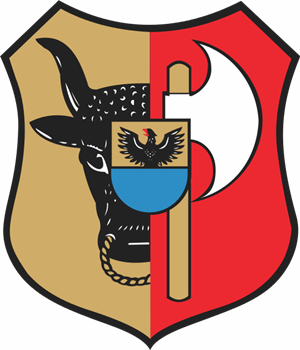 Leszno Travel Guide Leszno in central-western Poland in the province of Wielkopolskie. Leszno has a population of about 64,000 inhabitants.
Leszno Travel Guide Leszno in central-western Poland in the province of Wielkopolskie. Leszno has a population of about 64,000 inhabitants.
The town has cultural, business and educational ambitions, it has a history that is connected to King Stanisław Leszczyński of Poland. To day it is a centre for sports such as aviation and speedway.
Leszno is the town of King Stanislaus, scholars and Baroque architecture. Two main families were linked to the town, Leszczyński and Sułkowski and have been described as open-minded, tolerant, resourceful and prudent.
Leszno was founded on a charter dated 1547 obtained by a castellan from Przemęt, Rafał Leszczyński.
Help! I need information on this place to enable me to complete this page. If you can provide me with information please send it to me using the contact page.
Leszno Travel Guide
This is a travel Guide about the country of Polska which is located in central Europe. You are very welcome to visit my site and I hope that you will enjoy the experience.
My guide is easy to use as each village, town and city has it's own page with useful information for the visitor. Not all sections appearing on the left of my guide, on this place may have information as this is an ongoing project.
It may be the case that this location has not yet been reviewed and written about so if you can contribute any information about this place to improve this guide please send it to Leszno Travel Guide.
Accommodation in Leszno
You will find the full range of accommodation in this town from the most luxurious five star hotels with up to date and modern amenities to pensions (a type of guest house or boarding house) and rooms or apartments at very reasonable prices. Some of the larger towns and cities will also have hostels.
If you prefer to stay in a more rural location there are a number of “Agro” style of accommodation places on farms and in the countryside plus there may be camp sites nearby.
If you see something you like or wish to know more about please contact the accommodation directly as I do not take commission and I take the attitude that their own website will have more up to date details on what they offer than if I were to include it here.
If you wish to advertise your accommodation on Leszno Travel Guide please contact me.
Accommodation
This place to stay may just be the right accommodation for you.
| Name and website | Address | Type |
| Hotel Poland | Full Advert Example | Hotel Poland |
Activities & Attractions in Leszno
Unia Leszno are a motorcycle speedway team established in 1938 and based in Leszno. They compete in the Polish Ekstraliga and were league champions in the 2010 season. Unia Leszno home track is at the Alfred Smoczyk Stadium.
Aeroklub Leszczyński There is a large gliding club at Leszno which is part of the Polish Aero Club, Aeroklub Polski.
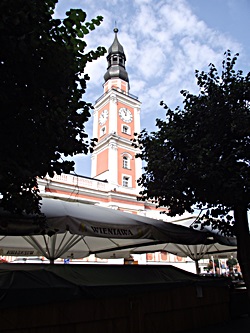 Poland is a country with a large variety of landscapes, a place where you can experience all four seasons. This provides the visitor with many opportunities for adventure and different activities and
visiting attractions, whether you enjoy the mountains, lakes, rivers or the beaches you will find something that suits you.
Poland is a country with a large variety of landscapes, a place where you can experience all four seasons. This provides the visitor with many opportunities for adventure and different activities and
visiting attractions, whether you enjoy the mountains, lakes, rivers or the beaches you will find something that suits you.
Poland is a country with a large variety of landscapes, a place where you can experience all four seasons. This provides the visitor with many opportunities for adventure and different activities and visiting attractions, whether you enjoy the mountains, lakes, rivers or the beaches you will find something that suits you.
If you see something you like or wish to know more about the activity or attraction please contact the provider directly as I do not take commission and I take the attitude that their own website will have more up to date details on what they offer than if I were to include it here.
What ever activity or attraction you run, if you wish to advertise on Leszno Travel Guide please let me know.
Activities & Attractions
| Name and website | Address | Type |
| Activity or attraction | ul.activity | Activity or Attraction |
Geography of Leszno
Leszno is located on the main road and rail routes linking the cities of Poznań to the north and Wrocław to the south. Situated in the southern part of the Greater Poland Voivodeship of Wielkopolska since 1999, it was previously the capital of the Leszno Voivodeship from 1975 until 1998.
History of Leszno
Leszno is the town of King Stanislaus, scholars and Baroque architecture. Two main families were linked to the town, Leszczyński and Sułkowski and have been described as open-minded, tolerant, resourceful and prudent.
Leszno was founded on a charter dated 1547 obtained by a castellan from Przemęt, Rafał Leszczyński, granted by King Sigismund the Old.
The town had it's best period in the first half of the 17th century as various religious refugees settled in the area including the Unity of Brethren from Moravia, Lutherans from Silesia, Jews, Scots, Italians and Hungarians. Together these groups formed a vibrant multilingual and multicultural community which had a forward looking outlook on life and helped in the development of the town.
Some of the most well known inhabitants of Leszno were: John Amos Comenius the last Bishop of the Unity of Brethren and an educationalist, Jan Johnson a scholar and doctor, Anna Memorata a poet of Czech origin who wrote in Latin and was the daughter of a pastor and preacher of the Bohemian Brethren in Leszno, Johann Heermann who started out writing Latin poetry, with his Flores ex Otfridi Evangeliorum vireto being published in 1609.
Education was an important function of life in the town with a number of schools being created including the Gymnasium run by the Unity of Brethren as well as printing houses. Many of the young people studded at universities abroad in Germany, Holland and Switzerland.
The Leszczyński family invited Italian architects to design a number of churches and other buildings in Leszno. The town traded through it's merchants all over Europe being famous for milling and cloth making and made carriages and wigs as luxurious items.
Museums in Leszno
Polska is full of history and the Polish are great lovers of knowledge of the past so you will find many museums in the country, whether it be a folk, military, science, skansen, transport or any other type.
Poland has a long history and has been an important trading route that has been invaded by many different groups over the past 1,000 years. Museums are a great way to explore the nations history about the inhabitants of the land in the past, their lives and customs.
Accept a free advert about your museum and include it below by writing an article about it here on David's Travel Guides. Follow the link for the article. For the rest, if you see something you like or wish to know more about please contact the museum directly as I take the attitude that their own website will have more up to date details on what they offer than if I were to include it here.
What ever museum you run, you can advertise it on Leszno Travel Guide at no cost.
Museums
The main location is situated in the 18th century pastor's house of the Holy Cross Church housing a number of collections about the history of the town and local region, including folk culture and paintings. The second site is the building of the former Synagogue at 31 Narutowicza Street which is called The Art Gallery.
The website has plenty of information in English.
| Name and website | Address | Type |
| www.muzeum.leszno.pl | pl. Jana Metziga 17 | Museum |
Places to Eat in Leszno
There are many restaurants covering the usual pizza to those offering local Polish traditional and regional cuisine.
If you see something you like or wish to know more about please contact the place to eat directly as I do not take commission and I take the attitude that their own website will have more up to date details on what they offer than if I were to include it here.
If you wish to advertise your cafe, restaurant or bar on Leszno Travel Guide please advise me.
Places to Eat
This place to eat may just be the right one for your pallet.
| Name and website | Address | Type |
| www.olimpleszno.pl | ul. Hungary 2, 64-100 Leszno | Restaurant |
Tourist Information in Leszno
David's Travel Guides This web site will eventually have tourist information on most of the places in Polska. Being a web site you will be able to access the information on most digital platforms, including your laptop, personal computer or a mobile phone.
Tourist organisations are welcome to contact me for details on how to display their information on Leszno Travel Guide.
PTTK Polish Tourist and Sightseeing Society is a non-profit organisation that you will find in many places in Poland.
It is one of the oldest tourist societies in Europe and was was created by the merger of two societies: Polish Tatry Society (1873) and Polish Country Lovers Society (1906).
Official Tourist Information Centres in Poland are divided into 1*, 2*, 3* and 4* Certified and Non-Certified. All Certified Tourist Centres provide information in one or more foreign languages and have an expanded range of services as compared to the Non-Certified.
Tourist Information
No further information as yet.
| Name and website | Address | Type |
| www.leszno.pl | ul.Slowianska | Offical Tourist Office |
Transport in Leszno
The railway and bus stations are situated just west of the the towns main street, ul. Slowianska, a few minutes walk. The railway station has been completely modernised. Trains from Leszno to Poznań should take about 1 hour 20 minuets but train travel in Poland can be slow, although it is improving as they update the track and rolling stock. Buses to Poznań take about the same time. Regio trains from Leszno to Wrocław take about 1 hour 45 minuets and the faster intercity takes about 1hour 20 minuets.
Eurolines also stop at Leszno on route to Berlin.
International airports in proximity to Leszno include Poznań airport (Port Lotniczy “Ławica”) about 70km and Wrocław airport (Port Lotniczy Wrocław S.A.) about 100km.
International roads include route E-261 (national road number 5) linking Poland's northern coast with The Czech Republic. National road number 12 Głogów-Jarocin, crosses Leszno from West to East.
The international airport for the region of Wielkopolskie is Poznań–Ławica Henryk Wieniawski Airport (IATA: POZ, ICAO: EPPO) and was built in 1913 being one of the oldest airports in Poland. Located 5 km (3.1 miles) west of Poznań city centre, it takes it's name from the neighbourhood of Ławica being part of the city's Grunwald district. The airport is situated in Jeżyce district.
Poznań–Ławica Henryk Wieniawski Airport is well-connected with the regional capital's centre by public transport. There are bus stops right in front of the passenger terminal and in its close vicinity. Currently four bus lines run between the airport and city centre, one of which – L – is an express line connecting the airport with the main train station. In front of terminal T3 arrival hall you can find a 24/7 taxi stand.
Transport
Stacja Lotnicza Poznań (Poznań Airport Station), was established as a Prussian military airport in 2013. The original facilities were there to fortify the Army Corps based in the Poznan, but the idea of buying a plane and building an airport was created in the editorial office of a local paper known as, “Posener Tageblatt”. The initiative was supported by the authorities of the city and the province and a special committee was set up to oversee the project. The success of the project was down to the interest by the local society for novelties regarding aviation.
The official opening ceremony took place on 26th August 1913 with Kaiser Wilhelm II in attendance and a parade by the Army Corps, accompanied by a large crowd of the inhabitants of the city. The Airport area of around 300 hectares included: grass airside, barracks, workshops and three halls planned for thirty aircraft. One of them, called Poznań, was bought from the funds raised by the newspaper, Posener Tageblatt team.
At the airport, before and during World War 1, there was a school for pilots and mechanics, aircraft were repaired and aviation equipment was also stored. After the war when the region previously under the Prussian rule remained under German authority, the airport played an important role during the Wielkopolska Uprising, also known as the Greater Poland Uprising or Posnanian War.
With the outbreak of battle on 27th of December 1918, the city was taken by the Polish forces, but a German military unit stationed in Ławica posed a serious threat. So when German commanders of the military air unit refused the option of conditional surrender, the Polish decided to take over the airport by force. It began at night on 5th of January 1919 with a troop of about 350-400 insurrectionists, supported by two cannons, they conquered the airport after a twenty-minute-attack. The Polish fighters took over the airport base and also obtained valuable equipment such as thirty airworthy combat and training aircraft including spare parts. After two further attempts by the Germans to recapture Poznań-Ławica Airport was unsuccessful, the first insurrection air force unit was established and started to play a significant role in the development of Polish aviation. From the moment of acquisition, it was decided to create a civil airport.
Poznań–Ławica airport has often been confused by pilots with a nearby airbase, Poznań–Krzesiny Airbase, which also has a 2,500 m (8,200 ft) runway. The runways are at approximately the same orientation: Ławica's is 11/29 (true heading: 108/288) and Krzesiny's is 12/30 (true heading: 117.9/297.9). The two runways lay in a nearly straight line, with Krzesiny coming up first on approaches from the east, the ones used most often. On the other hand, the Krzesiny airbase has two runways and lies south-east from the city centre, while Poznań–Ławica lies just to the west of it.
| Name | Type | URL |
| e-podroznik.pl | Bus & Train Timetables | www.e-podroznik.pl |
| Port Lotniczy | Airport | www.airport-poznan.com.pl |
| POLREGIO S.A. | Railways | polregio.pl/ |
Websites of Leszno
If you have a website that is an official one linked to this town, or you administer a local community or an important trade site please contact me here at Leszno Travel Guide as I may be interested in including it.
Websites
No further information as yet.
| Name and website | Address | Type |
| www.leszno.pl | ul. Kazimierza Karasia 15, Leszno | Offical Site |
Regional Links

Province
The Wielkopolskie Voivodship was created in 1989 and is located in west-central Poland.
Province

Places in Province
The cities, towns and villages of the region of Wielkopolskie.
Places in ProvinceMap of Leszno
Leszno Travel Guide Wielkopolskie David's Travel Guides


